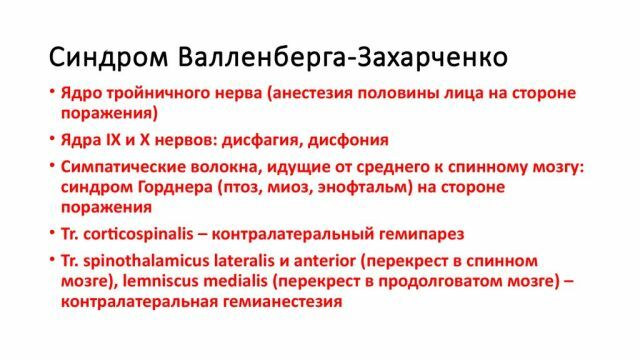 Peripheral paralysis is the result of the defeat of peripheral neurons responsible for motor functions. In this case, there is a loss of reflexes, degenerative muscle atrophy and hypotension.
Peripheral paralysis is the result of the defeat of peripheral neurons responsible for motor functions. In this case, there is a loss of reflexes, degenerative muscle atrophy and hypotension.
In addition, it should be noted that the process of changing the electrical excitability in the affected nerves, which is called degeneration, also starts. The severity of the disease is evidenced by the depth of change in electrical excitability.
Atony and loss of reflexes occurs due to a break in the work of the reflex arc, and along with it the muscles lose their tone. This factor does not give rise to the corresponding reflex. Dissociation of muscles with neurons of the spinal cord and causes their sharp weight loss and atrophy.
From neurons that are connected to the muscles along the peripheral nerve, there is a course of impulses responsible for the normal metabolism in the area of the muscle tissues.
When the muscles are affected, fibrillar twitchings are observed, which have the form of rapid contractions in the area of individual muscle fibers. Basically, these processes occur in the chronic form of the disease.
Occurrence of peripheral paralysis occurs with lesion of the peripheral nerve. In this case, sensitivity may be lost, and as a result, vegetative disorders develop in the affected area.
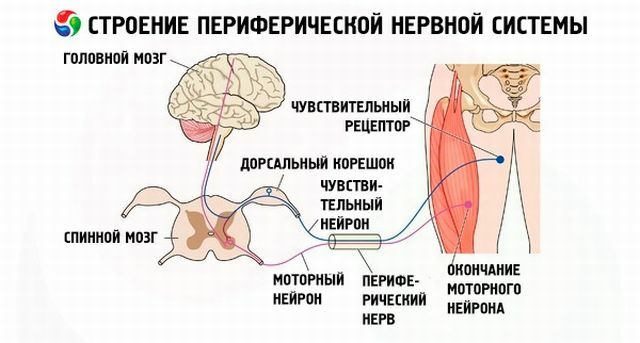
Contents
- The development process of the disease
- Factors affecting the development of the disorder
- Characteristic manifestations
- Diagnostic methods
- Medical care
- What is the risk of the disease?
- Preventive measures
The development process of the disease
The development of peripheral paralysis is associated with the defeat of the neuron responsible for movement and its axon. If only the nuclei of the cranial nerves and the anterior horns are affected, then together with the flaccid paralysis, spinal muscular atrophy can develop in parallel.
In addition, these two ailments are accompanied by characteristic fascicular twitchings. With deformation of the peripheral nerve, there is a great chance that the innervated muscle will be paralyzed. 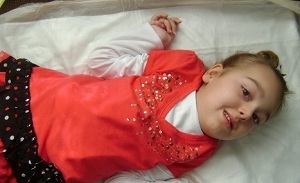
Peripheral paralysis and central - this is 2 pathologies, which are often mistaken for one disease or even completely confused.
But these are different violations. With central paralysis, the motor functions of the whole body are lost, the muscles are in constant tension. In addition, there are no signs of degeneration, and the muscles do not atrophy. In the case of damage to peripheral parts, the picture is different, or rather completely opposite.
Peripheral paralysis is a disease in which there is a decrease in muscle tone and paralysis of individual parts of the body.
Factors Affecting the Development of a Disorder
Symptoms of flaccid paralysis, such as loss of motor function, are not a self-contained disease, often caused by concurrent illnesses.
In fact, paralysis is a disorder in which a person makes involuntary movements. In some cases, patients can not move part of the body or are completely immobilized.
Partial loss of motor functions speaks of paresis. In any case, the disorder is evidence of damage to the nervous system, namely, the centers that are responsible for the movement, and peripheral departments. As the factors influencing the development of pathology, the following are noted:
- previous injuries;
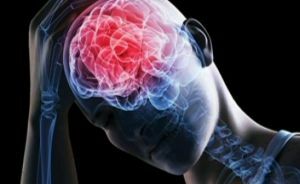
- metabolic problems;
- infectious diseases( syphilis, tuberculosis, encephalitis, meningitis and poliomyelitis);
- alimentary and toxic( pellagra, beriberi, heavy metal poisoning);
- oncological diseases;
- is a congenital and hereditary factor;
- intoxication;
- power system failure;
- diseases, the etiology of which remains unknown, for example, multiple sclerosis.
Characteristic manifestations of
Symptoms of peripheral paralysis:
- complete or partial loss of motor functions;
- reduction of muscle tone in the affected part;
- complete or partial absence of any reaction to sudden irritation of paralyzed muscles;
- observed denervation atrophy, that is, loss of muscle mass;
- there is also a reaction of degeneration or degeneration.
Over time, if a person does not receive proper treatment, peripheral paralysis can go into another form, that is, an acute infectious disease. It is often called poliomyelitis. It is characterized by intoxication, while the nervous system also suffers, paralysis and acute flaccid peripheral paresis develop.
This infection is excited by the filter virus, which is fairly stable and has increased sensitivity to ultraviolet radiation, disinfectants and high temperature.
When a virus enters the neuron, a dystrophic necrotic process is triggered, which is accompanied by the replacement by glial tissue of all the dead neurons and subsequent scarring. In turn, the more neurons die, the faster the paresis or paralysis.

Diagnostic methods
Diagnostic measures involve performing a whole complex of examinations:
- examination by a neurologist;
- basic examinations are given( general blood test and toxic);
- instrumental diagnostics( electroneuromyography, computed tomography, electroencephalography and magnetic resonance angiography);
- analyzes the patient's complaints and anamnesis( the time of inactivity of the muscles, the causes of complaints and the presence of the other relatives is revealed and what caused this reaction, that is, the place of work, etc.);
- is often examined by a neurosurgeon.
In addition to the basic methods, specialists conduct differential diagnosis of the disease. In this case, the identification of symptoms that are very easy to confuse with signs of central paralysis.
In addition, do not forget that in some cases, the lack of motor functions can be caused by any kind of injury and not always such a symptom is a sign of peripheral paralysis. Therefore, a complete examination of the patient to identify such injuries is carried out.
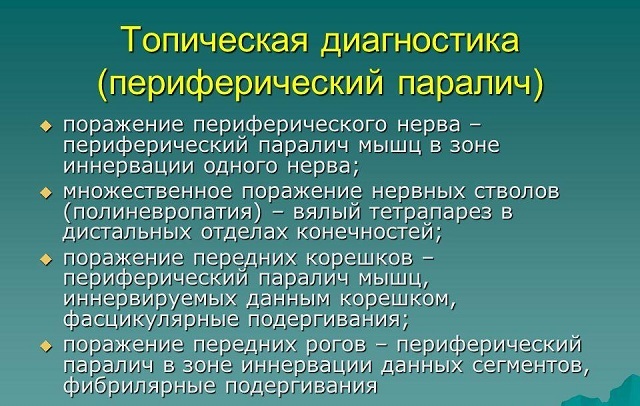
Medical assistance
First of all, the treatment is aimed at getting rid of the causes of the developmental diseases. In some cases, which are particularly difficult, specialists resort to surgical intervention.
This affects only that part of the spinal cord on which the damaged muscles are located. But do not forget that peripheral paralysis may not be a consequence of some other disease, but it is likely its development as an independent form of pathology.
The treatment uses a whole range of measures. At the same time, both medications and more common methods are used, such as physiotherapy and massage.
The main task of specialists is to completely return the patient's motor functions. If this is done, the chance of developing against this background other processes leading to deformation is significantly reduced.
All this time the patient should be under the supervision of a neurologist and follow all his instructions, including taking individually prescribed medications.
Among drugs that are often prescribed to patients suffering from flaccid paralysis, it is noted:
- Proserin;
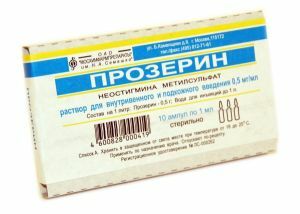
- Dibasol;
- Mellictin;
- solution of thiamine chloride.
In addition, physiotherapy is currently being actively used. This process takes quite a long time, but, nevertheless, it is this type of treatment that is most effective. If only this type of treatment is applied, the motor functions may not return completely, therefore a whole set of measures is mandatory.
How dangerous is the disease?
If the treatment is not properly administered or if all of the specialist's instructions are followed, some complications and completely unfavorable consequences may occur.
The most common are:
- in muscles, there may be a decrease or total absence of force, and on an ongoing basis;
- forms the immobility of the joint and the hardening of the muscles.
Preventive measures
In order to avoid the development of a disorder, experts recommend the following: 
- consult a doctor with the slightest symptoms of the disease and any other problems;
- blood pressure should always remain under control;
- treatment of infectious diseases in the early stages, preventing them from causing more serious problems;
- is best to exclude all bad habits - alcohol and smoking contribute to the development of many health problems, not only peripheral paralysis;
- effective prevention is the maintenance of a healthy lifestyle( proper nutrition, rest, compliance with the regime and physical exertion).

